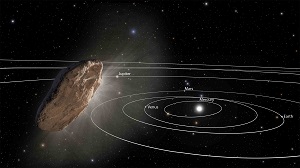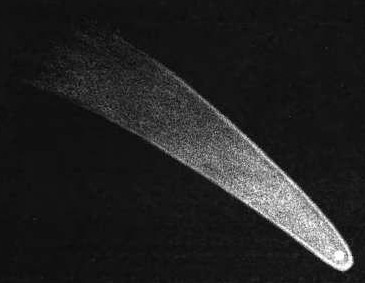
Visitor from interstellar space
By now I hope you’re heard about the interstellar interloper that’s been passing through the inner solar system recently. This asteroid, which has been named ‘Oumuamua, is the first-ever discovered object that has been observed coming into the solar system from elsewhere in the Milky Way that is larger than tiny bits of dust.
There are several known instances of objects being “ejected” out of our solar system, so periodically there should be a chance to see a passing object that has been “ejected” from some other solar system passing by us. But only objects that pass close to the Sun or those that cast their own light are bright enough to be seen.

‘Oumuamua was discovered on Oct. 19th when it was already more than a month past its closest point to the Sun. It’s only about 300 feet across, and it was close enough to Earth to be seen for a short while.
Objects passing through the solar system that aren’t gravitationally bound to the Sun must be moving very quickly, although all paths are bent around their closest point to the Sun. The eccentricity of an elliptical orbit around the Sun is represented in the mathematical elements of the orbit by a number between zero and 1. The eccentricity of an object that is going too fast to be captured by the Sun has a value between 1 and infinity. The value in this case is about 1.2, and the object’s velocity entering the solar system was about 59,000 mph. It was probably ejected from another star many light years away and millions of years ago, although it is from the “disk” of the Milky Way and not the more exotic “halo”. A “halo” object would probably be moving faster.
‘Oumuamua’s orbit can be simulated in Starry Night Dome. The orbital elements are a little on the uncertain side because of the short duration of observations between discovery and it zipping out of range. And the effect of the over-unity eccentricity appears to “break” the position of the object during times before February 2016 or after March 2019. But the 3 years when it’s at its closest point to the Sun are replicated pretty well.
To add ‘Oumuamua to SciDome Version 7, right-click on the Sun in Starry Night Preflight and select ‘New Asteroid…’ and enter the following values in the details window that pops up, using the ‘Pericentric’ method instead of ‘Near-Circular.’ Also pick an appropriate name in the ‘Untitled’ field.
E=1.1993471
Q=0.2552817
Node=24.5994750
W=241.6917568
I=122.6813370
Tp=2458005.98918377
Epoch=2458056.5Once you close this details window and “keep” the new object, and quit SciDome properly, the new object will be written to a file called “User Planets.ssd”. You need to copy this file from its location on Preflight to the Renderbox for it to be “live” on both computers.
c:\Users\Spitz\AppData\Local\Simulation Curriculum\Starry Night Prefs\Preflight\User Planets.ssdThis file needs to be copied and installed on the Renderbox at the comparable folder location:
c:\Users\Spitz\AppData\Local\Simulation Curriculum\Starry Night Prefs\Renderbox\User Planets.ssdPlease contact me if you need a little extra guidance on making this work. After this is done, the object should be “live” in Starry Night on the dome during the current “Now”.
You can also fly out to the object and watch the planets and the Sun fly by as its lumpy asteroid shape zooms past. I would recommend one special piece of orientation for objects like this. During SciDome training, one of the choices we emphasize when looking at a solar system object from above is that you can “Rotate With” or “Hover Over” the planet or moon below. If you “Rotate With” while looking down at the United States, and speed up time, the Earth won’t appear to rotate, you can see successive nightfalls and daybreaks over North America, and the background stars will rotate around in the background. If you “Hover Over”, as time passes North America will rotate away to the east, Asia will appear out of the west and the fixed stars won’t move. The Sun Angle won’t change much either.
There is a third option in the dropdown menu that allows you to choose “Rotate With” or “Hover Over”, which is very much like “Hover Over” but not quite. It’s called “Follow in Orbit.” The small difference between “Hover Over” and “Follow in Orbit” is that “Follow in Orbit” will maintain the phase of illumination by the Sun as the planet orbits the Sun, and the fixed stars will slowly sweep by although the Sun Angle won’t change as time passes. “Hover Over” is completely inertial – as the planet orbits the Sun, the phase of the Sun Angle will slowly change and only the fixed stars will stay fixed.
We don’t always drill down far enough to distinguish between “Hover Over” and “Follow in Orbit” because it takes more than a month of time flow to accumulate a 30° difference between the two. But in the case of ‘Oumuamua, because its position with respect to the Sun changes so quickly, you might want a way to keep the Sun Angle constant so the source of illumination won’t rotate away from your point of view and you “lose the light”. “Follow in Orbit” is a useful orientation choice for an object like this.
A little bit of hay has been made of the way the incoming path of ‘Oumuamua leads back towards the constellation Lyra. This can also be simulated in Starry Night. The brightest star in Lyra is Vega, which was the fictional location of the first extraterrestrial signals in the Carl Sagan novel Contact. Sagan may have picked Vega to use in his book because it has been known for some time that the motion of the Sun and the solar system through the Milky Way is in the general direction of that star.
The great American/Canadian astronomer Simon Newcomb wrote in Elements of Astronomy – a book Sagan would have known – “The motion of our solar system toward the constellation Lyra is one of the most wonderful conclusions of modern astronomy.” However, as we move in the direction of that constellation, Lyra and the other stars in it have their own movements that will scramble them all out in other directions as time passes.
The proper motions of the stars can also be turned on in Starry Night as a series of artificial lines, and simulated back and forth through a couple of hundred thousand years of movement centered on the present if you switch to a “Stationary Location.” These proper motions may appear random, but if you highlight some of the closest and most well-known nearby stars, you can track them moving away from or toward the direction of Lyra as time passes forward or backward with some coherence.

